




The abaya, similar to a cloak worn over the head and on top of the headscarf, conceals the shape of the body from head to toe, revealing just the face. It has an interesting but short history in the UAE – six or seven decades ago, this long, flowing black garment was relatively unknown, however, once the trend to wear it began, this simple garment quickly changed local fashion.
This type of full-body cloak is known in Egypt as milayah, in Morocco as jilabah, and in the Arabian Peninsula, the Levantine Arab States and Iraq as al-abaah or al-aba ‘Abā: (Arabic: outer cloak, Pl. ‘abā’āt, or ‘Ibī, synonyms: ‘abāyah, ‘abāh, ‘abāt, daffah, bisht, or mishlaḥ), public long and wide outer cloak without sleeves worn by both sexes. In time this article of dress evolved and changed in shape, style, and function., sometimes as dafah Daffah : (Arabic: side, synonyms: ‘Abā, ‘abāyah, ‘abāh, ‘abāt, bisht or mishlaḥ), long, wide, and sleeveless outer cloak worn in public by both sexes. In time this article of dress evolved and changed in shape, style, and function.. The shorter terms abah ‘Abāh: (Arabic: outer cloak, Pl. ‘abā’āt, or ‘Ibī, synonyms: ‘Abā, ‘abāyah, ‘abāt, daffah, bisht or mishlaḥ), public long and wide outer cloak without sleeves worn by both sexes. In time this article of dress evolved and changed in shape, style, and function. or aba ‘Abā: (Arabic: outer cloak, Pl. ‘abā’āt, or ‘Ibī, synonyms: ‘abāyah, ‘abāh, ‘abāt, daffah, bisht, or mishlaḥ), public long and wide outer cloak without sleeves worn by both sexes. In time this article of dress evolved and changed in shape, style, and function. (plural ibi ‘Ibī: (Arabic: pl. for ‘Abā: outer cloak, synonyms: ‘Abā, ‘abāyah, ‘abāh, ‘abāt, daffah, bisht or mishlaḥ), public outer cloak worn by both sexes. In time this article of dress evolved and changed in shape, style, and function.) is only used in the UAE. The modern version we know today is known as an abaya
According to the older generation UAE women, they did not grow up with the aba ‘Abā: (Arabic: outer cloak, Pl. ‘abā’āt, or ‘Ibī, synonyms: ‘abāyah, ‘abāh, ‘abāt, daffah, bisht, or mishlaḥ), public long and wide outer cloak without sleeves worn by both sexes. In time this article of dress evolved and changed in shape, style, and function.. “This practice is only recent. It came with the oil.”
The abaya was an expensive and very rare form of cover and was reserved for use by the elite and borrowed from them by the rest of the community for special occasions such as covering a bride on her wedding day as she was walked from her father’s home to her newlyweds family home. This was a great example of social collaboration and unity among the tribespeople.
Most women wore the shaylah Shaylah: (Colloquial Gulf Arabic), a length of fabric used as shawl Shawl: (Persian: shāl from Hindi: duśālā – Shoulder Mantle), a shawl is a South Asian version of a scarf Scarf: (English), usually a rectangular piece of cloth loosely worn over the shoulders, upper body and arms, and sometimes also over the head. worn or wrapped loosely over the shoulders and is usually made of wool. , head cover or veil. Also known as (wigāyah) or (milfa Milfa’: (Arabic: to cover), shawl Shawl: (Persian: shāl from Hindi: duśālā – Shoulder Mantle), a shawl is a South Asian version of a scarf Scarf: (English), usually a rectangular piece of cloth loosely worn over the shoulders, upper body and arms, and sometimes also over the head. worn or wrapped loosely over the shoulders and is usually made of wool. or veil worn by women in the Arab Gulf regions and some areas of the Levant to cover the head.’), generally made from sheer fabrics such as tulle (tūr), cotton gauze (wasmah Wasmah: (Arabic: woad), is derived from the woad herb (wasmah) used to dye the cotton gauze black. It is mainly used for headcovers or veils and overgarments in most of the Arab gulf region.) (nidwah) or (Nīl), or silk chiffon (sarī). that engulfed the full upper portion of their bodies together with a baggy thawb Thawb: (Arabic: thawb, Pl. Athwāb/thībān), can be pronounced thobe Thobe: (Arabic: thawb, Pl. Athwāb/thībān), can be pronounced thawb or tobe Tobe: (Arabic: thawb, Pl. Athwāb/thībān), can be pronounced thawb or thobe based on locale. The standard Arabic word for ‘fabric’ or ‘garment’. It can refer to a qamīs-like tunic worn by men and women in the Arabian Peninsula, Iraq, the southern and south-western ports and islands of Iran, and some countries in East and West Africa. More specifically, it can refer to the square-shaped Bedouin overgarment worn by women. based on locale. The standard Arabic word for ‘fabric’ or ‘garment’. It can also refer to a qamīs-like tunic worn by men and women in the Arabian Peninsula, Iraq, the southern and south-western ports and islands of Iran, and some countries in East and West Africa. More specifically, it can refer to the square-shaped Bedouin overgarment worn by women. or tobe Tobe: (Arabic: thawb, Pl. Athwāb/thībān), can be pronounced thawb or thobe based on locale. The standard Arabic word for ‘fabric’ or ‘garment’. It can refer to a qamīs-like tunic worn by men and women in the Arabian Peninsula, Iraq, the southern and south-western ports and islands of Iran, and some countries in East and West Africa. More specifically, it can refer to the square-shaped Bedouin overgarment worn by women. based on locale. The standard Arabic word for ‘fabric’ or ‘garment’. It can also refer to a qamīs-like tunic worn by men and women in the Arabian Peninsula, Iraq, the southern and south-western ports and islands of Iran, and some countries in East and West Africa. More specifically, it can refer to the square-shaped Bedouin overgarment worn by women in the Arabian Gulf region. (opens in a new tab)" href="https://thezay.org//the-story-of-the-uae-thawb/" target="_blank">thawb Thawb: (Arabic: thawb, Pl. Athwāb/thībān), can be pronounced thobe Thobe: (Arabic: thawb, Pl. Athwāb/thībān), can be pronounced thawb or tobe Tobe: (Arabic: thawb, Pl. Athwāb/thībān), can be pronounced thawb or thobe based on locale. The standard Arabic word for ‘fabric’ or ‘garment’. It can refer to a qamīs-like tunic worn by men and women in the Arabian Peninsula, Iraq, the southern and south-western ports and islands of Iran, and some countries in East and West Africa. More specifically, it can refer to the square-shaped Bedouin overgarment worn by women. based on locale. The standard Arabic word for ‘fabric’ or ‘garment’. It can also refer to a qamīs-like tunic worn by men and women in the Arabian Peninsula, Iraq, the southern and south-western ports and islands of Iran, and some countries in East and West Africa. More specifically, it can refer to the square-shaped Bedouin overgarment worn by women. or tobe Tobe: (Arabic: thawb, Pl. Athwāb/thībān), can be pronounced thawb or thobe based on locale. The standard Arabic word for ‘fabric’ or ‘garment’. It can refer to a qamīs-like tunic worn by men and women in the Arabian Peninsula, Iraq, the southern and south-western ports and islands of Iran, and some countries in East and West Africa. More specifically, it can refer to the square-shaped Bedouin overgarment worn by women. based on locale. The standard Arabic word for ‘fabric’ or ‘garment’. It can also refer to a qamīs-like tunic worn by men and women in the Arabian Peninsula, Iraq, the southern and south-western ports and islands of Iran, and some countries in East and West Africa. More specifically, it can refer to the square-shaped Bedouin overgarment worn by women in the Arabian Gulf region. to ensure full coverage. Societies were composed of small tribal units living in clusters and everyone knew each other through marital and kinship ties.
With the oil-boom came wealth, urbanisation and exposure to the rest of the world. These three elements were instrumental in the introduction of Abayat Ras, the black silk version of the abaya worn draped off the head to ensure more concealment when in public. By the 1980s, with girls entering higher education and the workforce, functionality dictated the evolution of the abaya into the robe-like garment we see today coupled with a narrower form of shaylah Shaylah: (Colloquial Gulf Arabic), a length of fabric used as shawl Shawl: (Persian: shāl from Hindi: duśālā – Shoulder Mantle), a shawl is a South Asian version of a scarf Scarf: (English), usually a rectangular piece of cloth loosely worn over the shoulders, upper body and arms, and sometimes also over the head. worn or wrapped loosely over the shoulders and is usually made of wool. , head cover or veil. Also known as (wigāyah) or (milfa Milfa’: (Arabic: to cover), shawl Shawl: (Persian: shāl from Hindi: duśālā – Shoulder Mantle), a shawl is a South Asian version of a scarf Scarf: (English), usually a rectangular piece of cloth loosely worn over the shoulders, upper body and arms, and sometimes also over the head. worn or wrapped loosely over the shoulders and is usually made of wool. or veil worn by women in the Arab Gulf regions and some areas of the Levant to cover the head.’), generally made from sheer fabrics such as tulle (tūr), cotton gauze (wasmah Wasmah: (Arabic: woad), is derived from the woad herb (wasmah) used to dye the cotton gauze black. It is mainly used for headcovers or veils and overgarments in most of the Arab gulf region.) (nidwah) or (Nīl), or silk chiffon (sarī)..
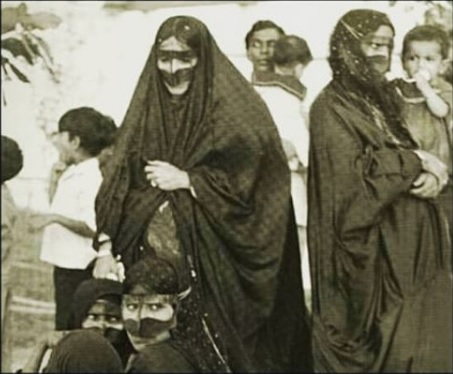
Although identical in concept and cut to the garment worn by men, the aba ‘Abā: (Arabic: outer cloak, Pl. ‘abā’āt, or ‘Ibī, synonyms: ‘abāyah, ‘abāh, ‘abāt, daffah, bisht, or mishlaḥ), public long and wide outer cloak without sleeves worn by both sexes. In time this article of dress evolved and changed in shape, style, and function. differs in fabric, colour and embellishments used, and of course, in the way it is worn. It is roughly a double square, 1.5 m in length and width with a front opening and two side slits barely large enough to allow the hands to poke through.
Piping, known as ghitan, made from black silk thread usually runs down the front edges and around the seam of the sleeves and in a wider band around the cuff. Sometimes golden metal braids (qasab) or embroidery decorates the sides of the central opening. It might include tassels made from the same thread.
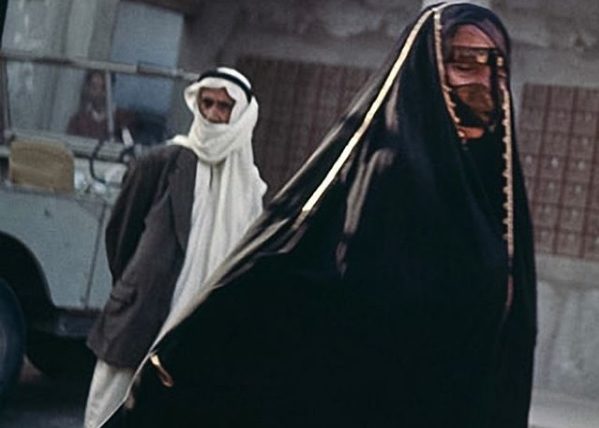
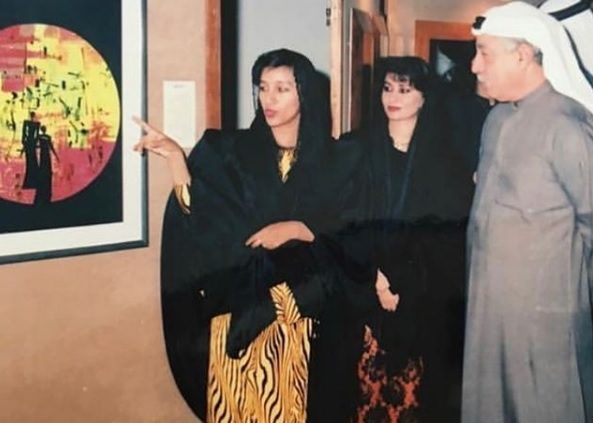
When UAE women first started wearing the aba ‘Abā: (Arabic: outer cloak, Pl. ‘abā’āt, or ‘Ibī, synonyms: ‘abāyah, ‘abāh, ‘abāt, daffah, bisht, or mishlaḥ), public long and wide outer cloak without sleeves worn by both sexes. In time this article of dress evolved and changed in shape, style, and function., they draped it from the centre of the crown. It extended loosely behind their backs as they walked, or they tucked the lower ends under one of their sides. In both cases the hands hardly ever extended through the openings, leaving the sides resembling wings flapping as they walked. At times, especially at the marketplace or when reaching to greet someone, the right side of the garment was pulled across the front using the left hand to cover part of the face. This ensured a modest cover and gave the right arm freedom to move through its opening to shake hands or touch items.
During the 1970s the lighter, sheer, silk aba ‘Abā: (Arabic: outer cloak, Pl. ‘abā’āt, or ‘Ibī, synonyms: ‘abāyah, ‘abāh, ‘abāt, daffah, bisht, or mishlaḥ), public long and wide outer cloak without sleeves worn by both sexes. In time this article of dress evolved and changed in shape, style, and function. became popular among UAE and Qatari women. In the UAE it was worn draped from the crown and then gathered up at the waist by holding it in both arms, revealing the lower portion of the dress beneath. This created a distinct UAE style.
Most women were still illiterate regarding detailed religious practices. The aba ‘Abā: (Arabic: outer cloak, Pl. ‘abā’āt, or ‘Ibī, synonyms: ‘abāyah, ‘abāh, ‘abāt, daffah, bisht, or mishlaḥ), public long and wide outer cloak without sleeves worn by both sexes. In time this article of dress evolved and changed in shape, style, and function. was relatively new to them and they treated it as they would a shaylah Shaylah: (Colloquial Gulf Arabic), a length of fabric used as shawl Shawl: (Persian: shāl from Hindi: duśālā – Shoulder Mantle), a shawl is a South Asian version of a scarf Scarf: (English), usually a rectangular piece of cloth loosely worn over the shoulders, upper body and arms, and sometimes also over the head. worn or wrapped loosely over the shoulders and is usually made of wool. , head cover or veil. Also known as (wigāyah) or (milfa Milfa’: (Arabic: to cover), shawl Shawl: (Persian: shāl from Hindi: duśālā – Shoulder Mantle), a shawl is a South Asian version of a scarf Scarf: (English), usually a rectangular piece of cloth loosely worn over the shoulders, upper body and arms, and sometimes also over the head. worn or wrapped loosely over the shoulders and is usually made of wool. or veil worn by women in the Arab Gulf regions and some areas of the Levant to cover the head.’), generally made from sheer fabrics such as tulle (tūr), cotton gauze (wasmah Wasmah: (Arabic: woad), is derived from the woad herb (wasmah) used to dye the cotton gauze black. It is mainly used for headcovers or veils and overgarments in most of the Arab gulf region.) (nidwah) or (Nīl), or silk chiffon (sarī).. UAE nationals were easily identified by the way they gathered their aba ‘Abā: (Arabic: outer cloak, Pl. ‘abā’āt, or ‘Ibī, synonyms: ‘abāyah, ‘abāh, ‘abāt, daffah, bisht, or mishlaḥ), public long and wide outer cloak without sleeves worn by both sexes. In time this article of dress evolved and changed in shape, style, and function. in their arms, lifting it as high as the waist from the front and up to the knees at the back, showing the full bottom part of the skirt underneath.
An aba ‘Abā: (Arabic: outer cloak, Pl. ‘abā’āt, or ‘Ibī, synonyms: ‘abāyah, ‘abāh, ‘abāt, daffah, bisht, or mishlaḥ), public long and wide outer cloak without sleeves worn by both sexes. In time this article of dress evolved and changed in shape, style, and function. was usually accompanied by a shaylah Shaylah: (Colloquial Gulf Arabic), a length of fabric used as shawl Shawl: (Persian: shāl from Hindi: duśālā – Shoulder Mantle), a shawl is a South Asian version of a scarf Scarf: (English), usually a rectangular piece of cloth loosely worn over the shoulders, upper body and arms, and sometimes also over the head. worn or wrapped loosely over the shoulders and is usually made of wool. , head cover or veil. Also known as (wigāyah) or (milfa Milfa’: (Arabic: to cover), shawl Shawl: (Persian: shāl from Hindi: duśālā – Shoulder Mantle), a shawl is a South Asian version of a scarf Scarf: (English), usually a rectangular piece of cloth loosely worn over the shoulders, upper body and arms, and sometimes also over the head. worn or wrapped loosely over the shoulders and is usually made of wool. or veil worn by women in the Arab Gulf regions and some areas of the Levant to cover the head.’), generally made from sheer fabrics such as tulle (tūr), cotton gauze (wasmah Wasmah: (Arabic: woad), is derived from the woad herb (wasmah) used to dye the cotton gauze black. It is mainly used for headcovers or veils and overgarments in most of the Arab gulf region.) (nidwah) or (Nīl), or silk chiffon (sarī). and a ghishwah Ghishwah: (Arabic: ghashā: to cover), the term is applied to any sheer fabric such as shawl Shawl: (Persian: shāl from Hindi: duśālā – Shoulder Mantle), a shawl is a South Asian version of a scarf Scarf: (English), usually a rectangular piece of cloth loosely worn over the shoulders, upper body and arms, and sometimes also over the head. worn or wrapped loosely over the shoulders and is usually made of wool. , head scarf Scarf: (English), usually a rectangular piece of cloth loosely worn over the shoulders, upper body and arms, and sometimes also over the head. or veil (shaylah) if draped off the head to conceal the face, in Arab gulf dialect. underneath. Though mainly worn outdoors, it was custom to not take it off outside of one’s own home, even in strictly female company. However, when the aba ‘Abā: (Arabic: outer cloak, Pl. ‘abā’āt, or ‘Ibī, synonyms: ‘abāyah, ‘abāh, ‘abāt, daffah, bisht, or mishlaḥ), public long and wide outer cloak without sleeves worn by both sexes. In time this article of dress evolved and changed in shape, style, and function. was removed in private it was always folded in a special way (tarbia) to palm size and placed to the right of the wearer.
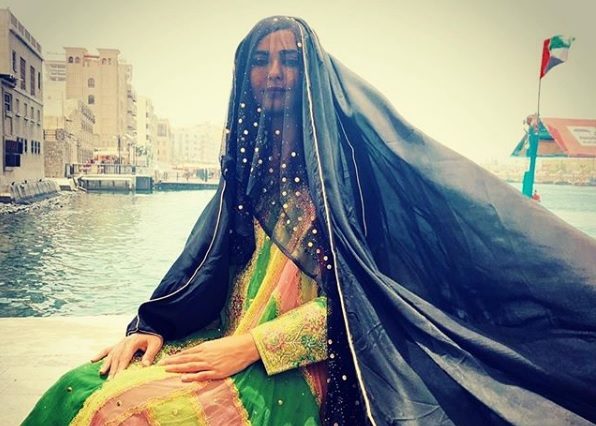
Ṭariq: (Arabic; Synonym: tulle_bi_talli; talli; badla; khus_dozi ), series of small metal knots made on a woven net ground as embellishment. The term is commonly used in the Levant Arab region specifically in Lebanon.
El Mutwalli (2011). Collection.During the 1980s the aba ‘Abā: (Arabic: outer cloak, Pl. ‘abā’āt, or ‘Ibī, synonyms: ‘abāyah, ‘abāh, ‘abāt, daffah, bisht, or mishlaḥ), public long and wide outer cloak without sleeves worn by both sexes. In time this article of dress evolved and changed in shape, style, and function. directly influenced dress ornamentation as all special design features and heavy embroidery were concentrated at the centre bodice Bodice: (English: body), or bodices the plural form of body, it is the close-fitting garment meant to cover the body above the waist or the torso. However, it was not until the 17th century that the term became synonymous to women’s undergarment. and yoke Yoke: (Synonym: Bodice_Yoke), a structured pattern fitted at the shoulders defining the structure of women’s garments. Introduced in c. 1880s it defines the transition between the upper and lower parts of the garments and can now be found stitched-in where the blouse is separated from the skirt by a horizontal seam. and the front part of the skirt for it to be visible through the front opening of the aba ‘Abā: (Arabic: outer cloak, Pl. ‘abā’āt, or ‘Ibī, synonyms: ‘abāyah, ‘abāh, ‘abāt, daffah, bisht, or mishlaḥ), public long and wide outer cloak without sleeves worn by both sexes. In time this article of dress evolved and changed in shape, style, and function.. In the early 1990s women began to spend large amounts of money on fashionable dresses by well known international couturiers, most of which did not concentrate their embellishments along the front and a different approach was needed to display their features. Designers and tailors began experimenting with lighter, more perforated types of materials such as lace to complement the dresses and reveal more of what lay beneath.
In the latter half of the 1990s women began to remove their abas and shaylahs when in private gatherings. The garments were either placed on a hanger by the entrance or it was folded to form a single length of cloth one shibir (25 cm) wide, then folded into a square and rolled. This ensured that the garment did not crease. It was then placed on the back of the woman’s seat, readily at hand if needed. This practice started with Iranian, Bahraini and Nadji women before being adopted by UAE women.
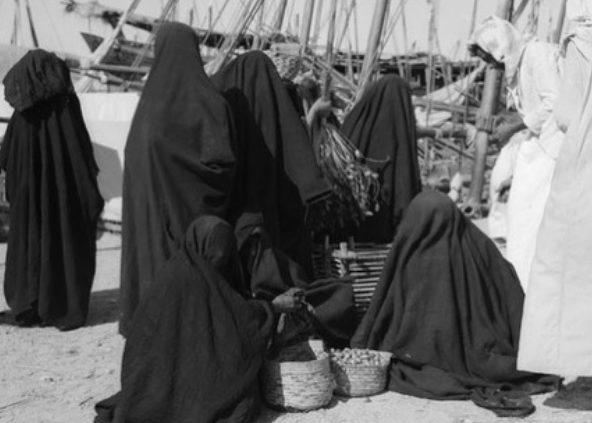
During the 1980s the shoulder abaya became popular in both the UAE and other Gulf states. This was mostly for practical reasons as it had fitted sleeves, creating a more manageable garment suited to modern life. Women started experimenting with modern fabrics and more elaborate embellishments and embroidery. It was accompanied by a narrower shaylah Shaylah: (Colloquial Gulf Arabic), a length of fabric used as shawl Shawl: (Persian: shāl from Hindi: duśālā – Shoulder Mantle), a shawl is a South Asian version of a scarf Scarf: (English), usually a rectangular piece of cloth loosely worn over the shoulders, upper body and arms, and sometimes also over the head. worn or wrapped loosely over the shoulders and is usually made of wool. , head cover or veil. Also known as (wigāyah) or (milfa Milfa’: (Arabic: to cover), shawl Shawl: (Persian: shāl from Hindi: duśālā – Shoulder Mantle), a shawl is a South Asian version of a scarf Scarf: (English), usually a rectangular piece of cloth loosely worn over the shoulders, upper body and arms, and sometimes also over the head. worn or wrapped loosely over the shoulders and is usually made of wool. or veil worn by women in the Arab Gulf regions and some areas of the Levant to cover the head.’), generally made from sheer fabrics such as tulle (tūr), cotton gauze (wasmah Wasmah: (Arabic: woad), is derived from the woad herb (wasmah) used to dye the cotton gauze black. It is mainly used for headcovers or veils and overgarments in most of the Arab gulf region.) (nidwah) or (Nīl), or silk chiffon (sarī). to cover the head.
In the 1990s more ostentatious fabrics, embroidery, rhinestones and crystals became fashionable, mostly in black-on-black embellishments, and shaylahs were designed to match the abayas. The Umaniyah style (named after Oman, as it resembles the tunics worn by Omani men) became popular. These garments differed from the normal shoulder abayas by having a cross-over front fastening. The left front fastened onto the right shoulder and the right front folded over the left fastening on the left shoulder completely covering the front view of the dress underneath. It is believed that this style came to the UAE via Saudi and was ‘imported’ by people attending the Hajj.
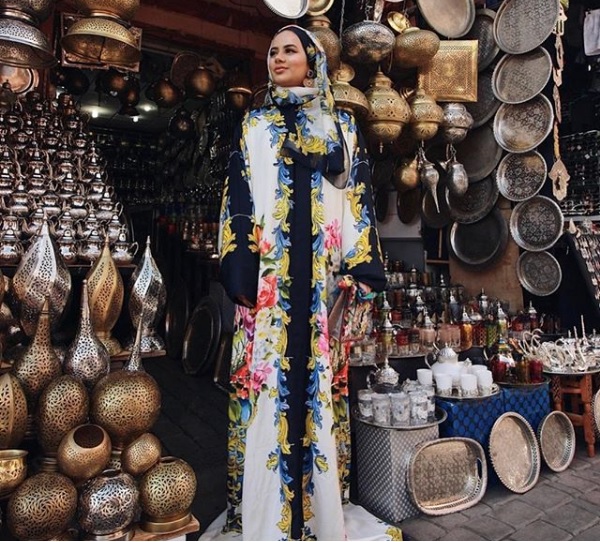
The early 2000s was a time of experimentation. New cuts and styles, sometimes resulting in bizarre and flamboyant designs, became fashionable. Some styles had narrow waists and wide belts to emphasise body shape, and hooded headcovers in an attempt to adopt western styles.
In the last few years women started moving away from all black abayas, experimenting with coloured shaylahs and embellishments. Designs are more individual and in tune with international trends. Today the abaya is a modern, fashion-forward garment, and rather than being used to hide an outfit, it has become an outfit in its own right. The growing popularity of the modest fashion movement contributed to this.